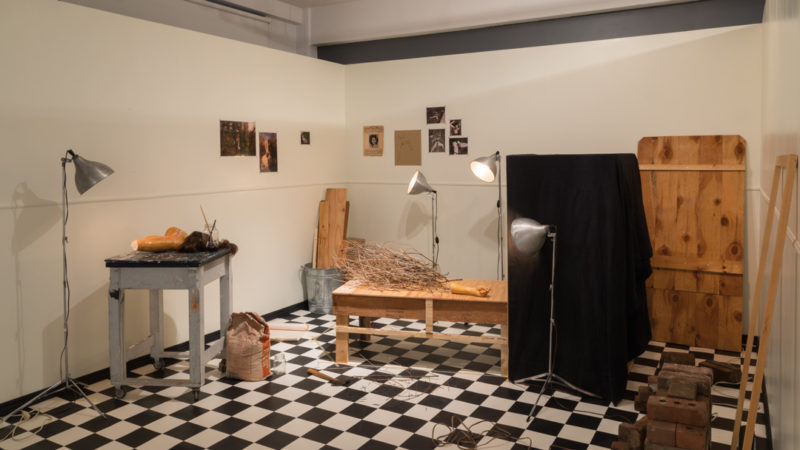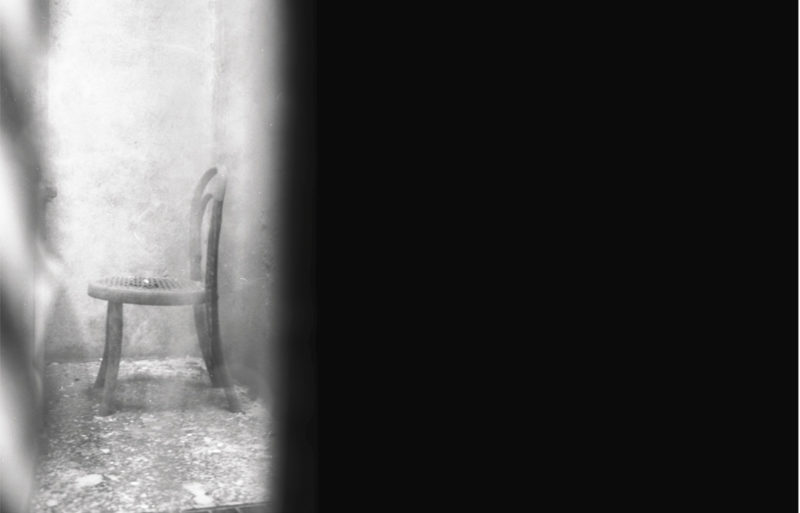[Spring-Summer 2018]
Behind Closed Doors: Body of Evidence
CIRCA, Montreal
January 20–March 10, 2018
Le point aveugle
Galerie Trois Points, Montreal
September 9–October 28, 2017
By James D. Campbell
Over the last several years, at exhibitions in Montreal and elsewhere, Montreal-based photographic artist Natascha Niederstrass has earned a strong reputation for informing her work with forensic-photography aesthetics and infusing it with a full measure of chilling, even spine-tingling, premises and implications. Her installations and photographic images require patient exploration and are slow to exorcise, difficult to forget. She uses great technical virtuosity in tandem with a remarkable gift for sustaining mood and generating aura in order to catch her viewers unawares until it is too late – and the result is an exalting frisson.
In her recent exhibition at Circa in Montreal, Behind Closed Doors: Body of Evidence, Niederstrass offers a powerful investigation of murder, mayhem, and misogyny. She focuses on the murder of twenty-two-year old aspiring actress Elizabeth Short, known popularly as the “Black Dahlia,” who was found murdered in Los Angeles in 1947, and she suggests that Marcel Duchamp may have been involved in Short’s murder. After the body – cut in half at the waist and drained of blood – was found in a vacant lot in Los Angeles, a massive police manhunt began. From the first, there was no shortage of suspects and scores of people confessed to the murder. Notably, Duchamp was not one of them. And the police were never able to marshal enough evidence to collar anyone.
Reimagining a 2015 exhibition held at Galerie 101 in Ottawa, Niederstrass takes as her point of fulcrum Duchamp’s Étant donnés (Given: 1° The Waterfall, 2° The Illuminating Gas) (1946–66) and his instruction manual for its assembly and disassembly, long ensconced in the annals of art history as a tour de force of high artistic invention. Niederstrass ably dismantles its author’s reputation in order to lay bare what she suspects is his secret history as a perp – and to lay bare the beating of what she suggests may have been a cold, dark heart.
Built over the course of two decades beginning in 1946 – notably, after Duchamp announced he was retiring from the practice of art to play chess – he executed Étant donnés in a secret workspace off the kitchen and bathroom of his tiny apartment in Greenwich Village. Niederstrass has meticulously reconstructed this workroom and asks, with coyly suggestive gravitas, is this a gifted artist’s refuge or the lair of a voyeur, or even a misogynistic murderer?
After Duchamp’s death, in 1968, Étant donnés was installed in the Philadelphia Museum of Art according to his detailed specifications. Viewers must peer through two tiny peepholes in a wooden door to experience the work: a tableau of a nude woman lying on her back with her face hidden, legs spread and sex visible, occupying a position similar to that of the Black Dahlia in the crime scene, recumbent on a pile of twigs. Some commentators suspected that the model was made of pigskin (which could then be read in very misogynistic terms), but in letters written by Duchamp to the Brazilian sculptor Maria Martins, with whom he was having an affair (during the early years of the construction), we learn that it was actually composed of parchment and plaster casts painted to resemble human skin. In their 2006 book The Exquisite Corpse: Surrealism and the Black Dahlia Murder,1 Mark Nelson and Sarah Hudson Bayliss point out that the disposition of the nude in Duchamp’s installation is nearly identical to that of the murder victim’s body, and they note that because Duchamp’s confidant, the eminent photographer Man Ray, was close friends with one of the suspects, George Hodel, Étant donnés was in large part based on the Short case.
Last fall, in her exhibition Le Point aveugle at Galerie Trois Points, Niederstrass essayed another kind of labyrinth in which the door was also left ajar, for those who dared to enter. She took as her starting point – and hence, our own – various photographs that she had taken in the Recoleta Cemetery in Buenos Aires. She made her usual judicious choice of images, then digitized her negatives and digitally post-processed those images. In so doing, she “enhanced” the images by occulting them as she saw fit, seeking to blur and scar them lightly, presumably to suggest age, accident, attrition, and the liminal. She then installed those images in relation to a handful of enigmatic objects – an undersized hand, a sealed “reliquary” containing cemetery detritus swept from the floor of a crypt – to deepen the overall sense of mystery as we moved through her maze, one that was both actual and aura-laden.
She draws upon the uncanny as Freud developed it in his 1919 essay “Das Unheimliche.”2 Freud referred specifically to a situation in which something can be both familiar and strange at the same time, inducing acute psychological discomfort, even a sense of jeopardy, and is often associated with a repressed memory that suddenly jumps into the foreground of consciousness, fraught with angst and shadowy foreboding. Inside Niederstrass’s beautifully constructed labyrinth, palpations of the uncanny can be found everywhere, from an empty child’s chair (Chaise d’enfant, 2017) to the open lid of a coffin (Suaire, cercueil et cadavre, 2017). Is this the domain of the mysterium tremendum, the nameless Other, the Demon of Death (as analytical psychologist Edgar Herzog understood it)? Herzog wrote that horror derives its character and power from its very incomprehensibility.3 Niederstrass is particularly gifted at summoning up a sense of the numinous in her installations, and preserving their enigmatic flavour. Herzog argued, “The world becomes ‘uncanny,’ and man feels that his whole existence is threatened and called into question.”4 Such strange dimensions open up everywhere in Niederstrass’s work – as they do in the vertical niche of light in Chapelle funéraire (2017), which does nothing to diminish the interior darkness but only amplifies it, as though opening the parentheses on an implacable darkness, one impervious to any illumination.
The heart of Niederstrass’s art practice is this preoccupation with darkness. One of its central themes is a no-holds-barred feminist exploration of violence against women based on sources that include crime-scene photography, murder cases, horror cinema, and the literature of the spectral and unseen. Compositionally faultless in their presentation, ambiguous in their meaning, yet rapacious in their haunting overtures, these installations and photographic images nestle in our minds like insistent poltergeists that refuse to be tidily solved or dumbed down. Perhaps this is because the uncanny ushers in another way of thinking about beginning – and being.5 The beginning is a delicate place, and one that is always already haunted. The ghosts are restless and feral. Niederstrass calls them up.
2 See Sigmund Freud [1919], “The Uncanny,” in The Complete Psychological Works of Sigmund Freud, standard ed., Vol. 17 (London: Hogarth Press, 1964), 217–56.
3 Edgar Herzog, Psyche and Death: Archaic Myths and Modern Dreams in Analytical Psychology, trans. David Cox and Eugene Rolfe (London: Hodder and Stoughton, 1966), 23.
4 Ibid., 24.
5 See Nicholas Royle, The Uncanny (New York: Routledge, 2003), 1.
James D. Campbell is an author and curator. He writes often on photography and painting from Montreal, where he lives.
[ Complete issue, in print and digital version, available here : Ciel variable 109 – REVISIT ]
[ Individual article in digital version, in French only, available here : Natascha Niederstrass, Behind Closed Doors: Body of Evidence | Le point aveugle – James D. Campbell ]



